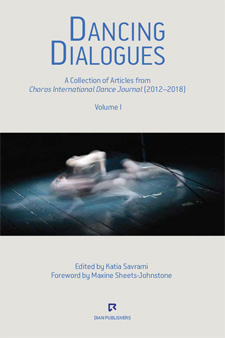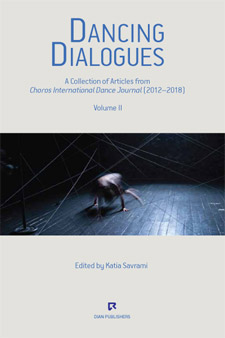Dancing Dialogues | 2019, 2020
In the course of seven years (2012–2018), corresponding to seven online issues of Choros International Dance Journal, a very fruitful collaboration and dialogue developed between Greek and international dance scholars (Εditorial Βoard members, contributors, and reviewers), which resulted in the publication of the Dancing Dialogues anthology. Published in two thematically structured volumes of selected articles from Choros International Dance Journal, the main aim of the book is to further the journal’s scholarly impact on the dance world.
 Volume I
Volume I
Dancing Dialogues: A Collection of Articles from Choros International Dance Journal (2012-2018), Volume I. Edited by Katia Savrami. Foreword by Maxine Sheets-Johnston. Athens: DIAN Publishers, 2019.
The first volume of Dancing Dialogues consists of two thematic sections: the first one covers various aspects of the “Theory and History of Dance”, whilst the second one focuses on “Modes of Research in Dance”. Although the variously themed articles can be read individually depending on the readers’ research interests and preferences, they may also be approached as constituent chapters of a book with an interdisciplinary approach at its core.
SECTION 1, On Theory and History
1. MAXINE SHEETS-JOHNSTONE, “Moving in Concert”
2. RAMSAY BURT, “Odysseus Weeping”
3. GRAHAM McFEE, “In Remembrance of Dance Lost”
4. EFROSINI PROTOPAPA, “On (Not-)Becoming Repertoire: Re-doing Appropriation in Contemporary Choreography”
5. SAMUEL N. DORF, “Eva Palmer-Sikelianos Dances Aeschylus: The Politics of Historical Re-enactment when Staging the Rites of the Past”
6. NATALIE ZERVOU, “Appropriations of Hellenism: A Reconsideration of Early Twentieth-Century American Physical Culture Practices”
7. NINOTCHKA D. BENNAHUM, “The Founding of American Ballet Theatre on the Eve of War, 1939–1944: Depression, Modernity and the Holocaust”
SECTION 2: Modes of Research in Dance
1. ROBIN NELSON, “On the Methodology of Practice as Research”
2. KAREN CHRISTOPHER, “Explaining a Dream: Writing the Simultaneity of Performance (Practice-based Research)”
3. STERIANI TSINTZILONI, “Towards a Methodology for Studying Greek Dance”
4. ARIADNE MIKOU, “Demolition: A Destabilizing Force for Transgressing Artistic Disciplines”
5. DIONYSIOS TSAFTARIDIS, “Fictional Screendance Typology”
ΠΑΡΑΓΓΕΙΛΕΤΕ ΤΟΝ ΠΡΩΤΟ ΤΟΜΟ
 Volume II
Volume II
Dancing Dialogues: A Collection of Articles from Choros International Dance Journal (2012-2018), Volume II. Edited by Katia Savrami. Athens: DIAN Publishers, 2020.
The second volume of Dancing Dialogues also carries the “dialogue” into further areas of research and theory, detailing the growing importance of interdisciplinary scholarship in Dance Studies. The volume is thus structured in two thematic sections: Section 1 covers various aspects of “Dance Politics, Activism and Queerness”, whilst Section 2 consists of articles discussing “Issues on Dance Education”.
SECTION 1: On Dance Politics, Activism and Queerness
1. SHERRY B. SHAPIRO, “The Act of Making: Dance as Aesthetic Activism”
2. NANDO MESSIAS, “Injurious Acts: A Struggle with Sissy in Performance”
3. EFVA LILJA, “Think, Talk, Act and Enjoy! On Artistic Interventions for Change”
4. CHARITINI TSIKOURA, “Trajal Harrell’s Antigone Sr. / Twenty Looks or Paris is Burning at the Judson Church (L): Antigone Voguing on a Catwalk?”
5. ΙΟΑΝΝΑ ΤΖΑRΤΖΑΝΙ, “Embodying the Crisis: The Body as a Site of Resistance in Post-bailout Greece”
6. ANN COOPER ALBRIGHT, “Taking the Next Step: Dance Advocacy in Greece”
SECTION 2: Issues on Dance Education
1. JO BUTTERWORTH, “Dance Artists in Academia: Developing a BA Course in the Maltese Context”
2. PAULINE BROOKS, “Dancing from a Distance: International Collaboration in Higher Education via the Internet”
3. PEGGY GOULD, “Dancing Toward Inclusion: Embedded Assumptions and Innovations in Functional Anatomy”
4. ERICA STANTON, “Movement, Myths and Metaphors: A Story of the Dance Technique Class and its Demise”
5. ASPASIA DANIA, MARIA KOUTSOUBA, VASILIKI TYROVOLA, “The Ability of Using Symbols and its Contribution to Dance Learning: The Laban Notation System”
ΠΑΡΑΓΓΕΙΛΕΤΕ ΤΟΝ ΔΕΥΤΕΡΟ ΤΟΜΟ
 Volume I
Volume I Volume II
Volume II